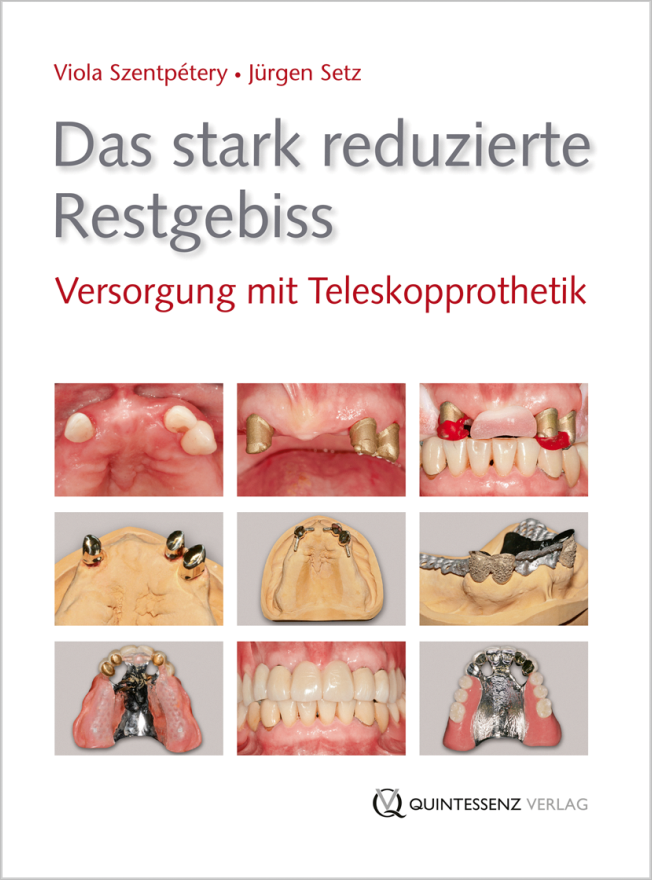QZ - Quintessenz Zahntechnik, 6/2018
BasicsSeiten: 820-840, Sprache: DeutschSzentpétery, Viola / Setz, JürgenDamit Teleskopprothetik erfolgreich und möglichst stabil eingesetzt werden kann, müssen in Abhängigkeit von der Ausgangslage des Patienten verschiedene Parameter beachtet werden. Die Autoren beschreiben das Prinzip der Friktion, den Umgang mit verschiedenen Legierungen und Metallen, die Gestaltung von Primär- und Sekundärkronen unter perioprothetischen Aspekten sowie die Gestaltung des abnehmbaren Prothesenteils. Der Beitrag ist ein Auszug aus dem 2015 im Quintessenz Verlag erschienen Buch "Das stark reduzierte Restgebiss" von Viola Szentpétery und Jürgen Setz.
Schlagwörter: Doppelkronen, Teleskopkronen, Friktion, Primärkronen, Sekundärkronen
The International Journal of Prosthodontics, 3/2012
PubMed-ID: 22545250Seiten: 217-220, Sprache: EnglischSzentpétery, Viola / Lautenschläger, Christine / Setz, Jürgen M.Clinical outcomes for frictional telescopic crowns supporting removable prostheses in patients with severely reduced dentitions with one to three remaining teeth per arch have been inadequately documented. Seventy-four patients with severely reduced dentitions received 82 telescopic removable partial dentures that were supported by 173 frictional telescopic crowns. The recorded individual telescopic abutment survival rate over a 60-month period was 80.6%. This observation was significantly influenced by sex and tooth vitality and mobility (Kaplan-Meier). The risk of loss of telescopic crowns was significantly influenced by sex, arch, vitality, and abutment tooth distribution (Cox regression). Telescopic removable partial dentures were proven to be a favorable treatment concept for severely reduced dentitions in the selected group of patients.
Quintessence International, 9/2010
PubMed-ID: 20806099Seiten: 749-758, Sprache: EnglischSzentpétery, Viola / Lautenschläger, Christine / Setz, Jürgen M.Objectives: The longevity of frictional telescopic crowns (FTC) in severely reduced dentitions with 1 to 3 remaining teeth per jaw has not yet been studied prospectively and exclusively. Aims of this study were to estimate risks of telescope loss and abutment tooth loss and to determine abutment tooth mobility over time.
Method and Materials: A total of 74 patients with severely reduced dentitions received 82 telescopic removable partial dentures (TRPDs) retained with 173 FTCs. Dentures were reexamined after 1 week and 3, 6, 12, 18, 24, 30, and 36 months. Tooth mobility was monitored with Periotest values. Adjuvant therapies were carried out if necessary. Survival probabilities of telescopes and abutment teeth as well as the influence of clinical factors (age, sex, jaw, vitality, opposing dentition, axis inclination, end Periotest value, crown length, crown margin quality, wearing mode, tooth types, abutment distribution, number of telescopes) were calculated with Kaplan-Meier estimators. The relative risks for telescope loss were calculated with Cox regression.
Results: The survival rate was 93.9% for abutment teeth and 87.5% for telescopes. Number of telescopes, abutment distribution, vitality, and gender as factors influenced the survival rates (Kaplan-Meier). In combination with the jaw as a factor, these affected the risk for telescope loss (Cox regression). Periotest values (mean of abutment teeth per examination) decreased significantly (P .0001). Altogether, 11% of teeth fractured and 4.6% of teeth were extracted. Patients were mostly very satisfied.
Conclusion: TRPDs proved to be a favorable treatment concept for severely reduced dentitions. FTCs can be considered as elements with a good benefitmaintenance relation. A general increase of abutment tooth mobility could not be verified.
Schlagwörter: abutment tooth mobility, frictional telescopic crowns, Periotest values, prospective clinical study, severely reduced dentition, survival probability





